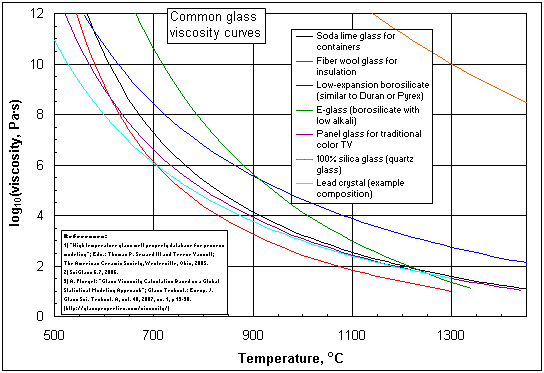
Glass viscosity example curves, derived from experimental data, except lead crystal glass based on model [1] - Glass compositions: see common glasses, Lead crystal composition, wt%: 56 SiO2, 35 PbO, 7 K2O, 2 Na2O. (click image to enlarge)
|
|
Glass Viscosity Calculation
Viscosity calculation based on 2200 experimental data:
"Glass Viscosity Calculation Based on a Global Statistical Modeling Approach" (PDF, 3 MB) [1]
A global statistical glass viscosity model was developed for predicting the complete viscosity curve, based on more than 2200 composition-viscosity data of silicate glasses from the scientific literature, including soda-lime-silica container and float glasses, TV panel glasses, borosilicate fiber wool and E type glasses, low expansion borosilicate glasses, glasses for nuclear waste vitrification, lead crystal glasses, binary alkali silicates, and various further compositions from over half a century. It is shown that within a measurement series from a specific laboratory the reported viscosity values are often over-estimated at higher temperatures due to evaporation losses during the measurement and glass preparation, including data by Lakatos et al. [4] and the recently published "High temperature glass melt property database for process modeling" by Seward et al. [2]. Similarly, in the glass transition range many experimental data of borosilicate glasses are reported too high due to phase separation effects. The developed global model corrects those errors. The model standard error was 9-17°C, with R² = 0.985-0.989. The prediction confidence interval largely depends on the glass composition of interest, the composition uncertainty, and the viscosity level. The mixed-alkali effect for the viscosity is shown to be caused mainly not by alkali-alkali but by non-linear alkali-silica interactions.
Download viscosity calculator, including correlation matrices, 1.7 MB
Comparison to other glass viscosity models
Viscosity Measurement Techniques
Glass Viscosity Fixpoints & Viscosity Units

Glass viscosity example curves, derived from experimental data, except lead crystal glass based on model [1] - Glass compositions: see common glasses, Lead crystal composition, wt%: 56 SiO2, 35 PbO, 7 K2O, 2 Na2O. (click image to enlarge)
Older viscosity model version, glass viscosity calculation based on 780 experimental data of 300 compositions:
"Improved compositio-property relations in silicate glasses, part I: Viscosity" [3]
The viscosity of over 300 compositions including soda-lime glasses, borosilicates, glasses with high alkaline earth content, NIST glass viscosity standards, lead silicates, fluorosilicates, and phospho-silicates have been examined. Using multiple regression modeling, linear and multiplicative relations between the chemical composition and the viscosity were developed. The described relations have been found to link data of different authors and compositions into one global equation which (a) allows validation of glass property datasets, (b) quantifies the influences of glass components and component interactions, and (c) allows some conclusions regarding the nature of glass. The analysis so far makes it possible to estimate the viscosity isokoms at log(viscosity/Pa*s) = 12.0 with an error of 7°C, at log(viscosity/Pa*s) = 6.6 with an error of 9°C, and at log(viscosity/Pa*s) = 1.5 with an error of 17°C. For industrial glasses the developed models are superior to previous work by maintaining or improving the prediction accuracy, and/or by extending the composition area covered, and through an advanced data analysis technique.
Download viscosity calculator, 0.14 MB
The simple models in ref. [2] (download software, 0.1 MB, English) are only recommended for soda-lime container and float glasses.
- Software in deutscher Sprache -
[1] A. Fluegel: "Glass Viscosity Calculation Based on a Global Statistical Modeling Approach"; (PDF, 3 MB), Glass Technol.: Europ. J. Glass Sci. Technol. A, vol. 48, 2007, no. 1, p 13-30.
[2] A. Fluegel, D. A. Earl, A. K. Varshneya, D. Oksoy: "Statistical analysis of viscosity, electrical resistivity, and further glass melt properties", Chapter 9 in: "High temperature glass melt property database for process modeling"; Eds.: T. P. Seward III and T. Vascott; The American Ceramic Society, Westerville, Ohio, 2005, ISBN 1-57498-225-7
[3] A. Fluegel, A. K. Varshneya, D. A. Earl, T. P. Seward, D. Oksoy: "Improved composition-property relations in silicate glasses, part I: Viscosity"; Ceramic Transactions, vol. 170, Melt Chemistry, Relaxation, and Solidification Kinetics of Glasses - Proceedings of the 106th Annual Meeting of the American Ceramic Society, 2005, p 129-143
[4] T. Lakatos, L.-G. Johansson and B. Simmingskold, "Viscosity temperature relations in the glass system SiO2-Al2O3-Na2O-K2O-CaO-MgO in the composition range of technical glasses"; Glass Technology, vol. 13, no. 3, June 1972, p 88-95